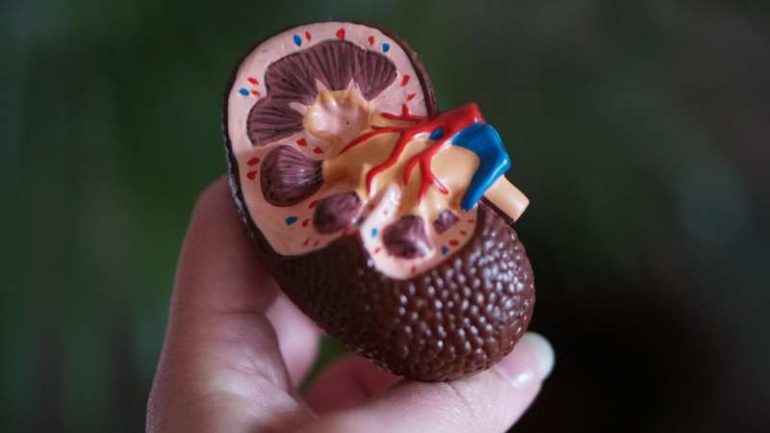Our kidneys are charged with the extraordinary task of filtering about 53 gallons of fluid a day, a process that depends on podocytes, which are tiny, highly specialized cells in the cluster of blood vessels in the kidney where waste is filtered that are highly vulnerable to damage.
In research at the MDI Biological Laboratory in Bar Harbor, Maine, a team led by Iain Drummond, Ph.D., director of the Kathryn W. Davis Center for Regenerative Biology and Aging, has identified the signaling mechanisms underlying podocyte formation, or morphogenesis. The discovery opens the door to the development of therapies to stimulate the regeneration of these cells, which are vital to ridding the body of toxins.
“Podocytes play a very important role in kidney function,” said Hermann Haller, M.D., president of the MDI Biological Laboratory and a nephrologist who leads the department of nephrology and hypertension at Hannover Medical School in Hanover, Germany. “The discovery of the signaling underlying podocyte morphogenesis by a team led by Iain Drummond is a major stride forward in the treatment of kidney disease.”
The study, entitled “Autonomous Calcium Signaling in Human and Zebrafish Podocytes Controls Kidney Filtration Barrier Morphogenesis,” was recently published in the Journal of the American Society of Nephrology.
In addition to Drummond, authors include Melissa Little, Ph.D., Aude Dorison, Ph.D., Irene Ghobrial and Alejandro Hidalgo-Gonzalez, Ph.D., all of The Royal Children’s Hospital, Murdoch Children’s Research Institute in Melbourne, Australia; Heiko Schenk, M.D., and Jan Hegermann of Hannover Medical School, Hanover, Germany; and Lynne Staggs of Hannover Medical School and the MDI Biological Laboratory.
The discovery of the signaling mechanism underlying podocyte formation is relevant to the treatment of a range of kidney conditions that can damage the glomerular filtration barrier, including acute kidney injury, developmental defects, premature birth defects, kidney cancer, polycystic kidney disease and chronic kidney disease (CDK) caused by diabetes or hypertension.
A major public health threat
In recent years, CDK has emerged as a major public health threat, especially among those age 60 and over, due to diabetes, hypertension and cardiovascular disease, all of which can contribute to kidney damage and all of which are increasing due to the aging of the world’s population. Approximately 38 million Americans, or 15 percent of the adult population, is estimated to have kidney disease.
When kidneys fail, the usual treatment is dialysis, an expensive, time-consuming procedure in which the blood is cleansed by an external filtering device. Though transplantation is another option, only a fraction of the tens of thousands of end-stage renal disease patients waiting for a kidney transplant receive one because the number of organ donors is insufficient to meet demand.
As a result of the limited options, kidney research at the MDI Biological Laboratory has focused on the regeneration of kidney tissue, and especially of nephrons, the functional units of the kidney, which include the glomerulus, in which the work of filtering the blood takes place. The approximately 1 million glomeruli in the body filter excess fluid and waste products from the blood, preventing the build-up of toxic waste.
The membrane of the glomerulus is lined with podocytes, whose interdigitated, foot-like projections (podo is Latin for “having a foot”) extend into the glomerular space. The podocytes are connected by a thin, mesh-like web called a “slit diaphragm” that functions as the final filtration barrier before fluid enters the glomerular space, from which it passes into collecting tubules and is ultimately excreted as urine.
“Podocytes are complex, which increases their vulnerability to injury,” Drummond explained. “There are many moving parts that have to come together just right in order to create the filtration barrier, and defects in any one of these can lead to disease. The more we know about how the individual parts and processes work together, the more targets we have for potential therapeutic interventions.”
In in vivo studies in zebrafish embryos and in vitro studies in maturing human kidney organoids, which are stem cell-derived “organs in a dish,” Drummond and his colleagues have discovered that calcium signaling is required for the formation of the podocyte foot process and slit diaphragm. The discovery supports the critical role of calcium signaling in the formation of the filtration barrier.
The discovery was enabled by a genetically encoded, green fluorescent calcium biosensor, GCaMP, that can be targeted to specific cell types. Because it lights up when calcium signaling is active, the biosensor allows scientists to image calcium signaling in the podocytes of transparent zebrafish embryos in real time under a fluorescence microscope to determine how they are made and what goes wrong during disease.
The zebrafish as a model for human disease
An important outcome of Drummond’s research is the establishment of the zebrafish as a model for human glomerular development and disease. The functional equivalency of podocytes in zebrafish and in human organoids suggests that their role has been conserved through evolution, thus validating the relevance of the zebrafish as a vertebrate model and as a screening platform for new therapies.
The research also identifies new routes for promoting kidney regeneration in humans. Unlike humans, zebrafish regenerate glomeruli throughout their adult lives. Though it is unknown if the signaling mechanisms employed during development are recapitulated during regeneration, Drummond thinks this is likely, in which case a deeper understanding could lead to therapies to trigger regeneration in humans.
“We wanted to go beyond looking at the shape and size and movement of cells during the process of forming the filter to the signals they are passing to generate this complex filter architecture,” Drummond said. “Once we understand these signals, we can accelerate tissue formation by promoting productive regenerative communication though our own messages in the form of signaling molecules.”
In recent years, the MDI Biological Laboratory has become a hub for kidney regeneration research due to its participation in a National Institutes of Health (NIH)-funded consortium, (Re)Building a Kidney (RBK), the aim of which is to develop a biological artificial kidney. The discovery of the signaling mechanism underlying podocyte formation will play a critical role in generating replacement kidney tissue.
In making his discovery, Drummond is building on the MDI Biological Laboratory’s distinguished historical reputation in kidney physiology. Much of what is known today about human kidney function was discovered at the MDI Biological Laboratory in the 20th century through comparative biological studies.
A master regulator of kidney health?
More information:
Lydia Djenoune et al, Autonomous Calcium Signaling in Human and Zebrafish Podocytes Controls Kidney Filtration Barrier Morphogenesis, Journal of the American Society of Nephrology (2021). DOI: 10.1681/ASN.2020101525
Provided by
Mount Desert Island Biological Laboratory
Citation:
Scientist identifies process critical to kidney function (2021, May 4)
retrieved 4 May 2021
from https://medicalxpress.com/news/2021-05-scientist-critical-kidney-function.html
This document is subject to copyright. Apart from any fair dealing for the purpose of private study or research, no
part may be reproduced without the written permission. The content is provided for information purposes only.



